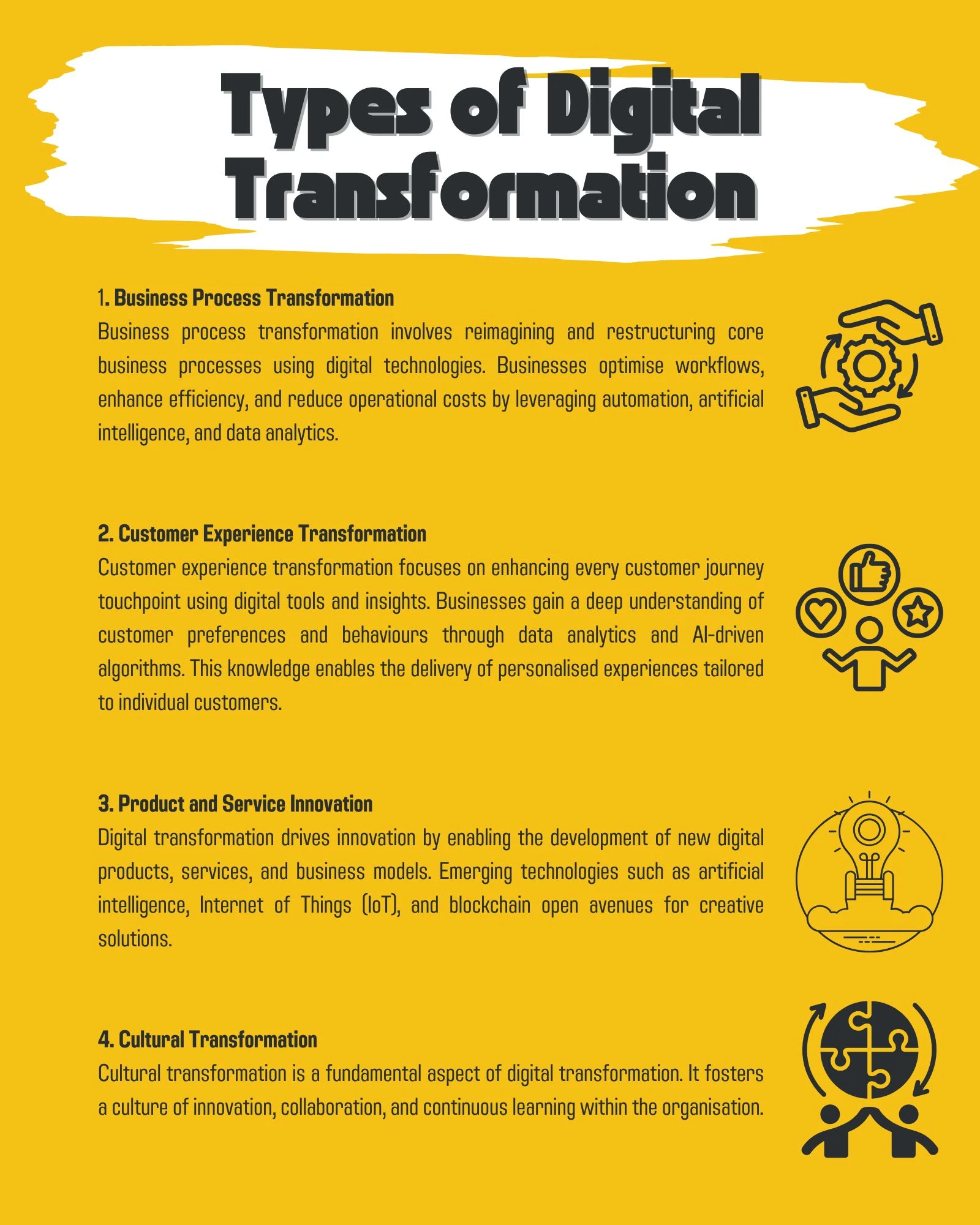- Table of Contents
- What Is Digital Transformation?
- Benefits of Digital Transformation
- Enhanced Operational Efficiency
- Improved Customer Experience
- Increased Agility and Innovation
- Data-Driven Decision-Making
- Cost Optimisation
- Enhanced Supply Chain Management
- Improved Regulatory Compliance and Risk Management
- Increased Environmental Sustainability
- Enhanced Employee Productivity and Engagement
- Faster Time-to-Market for Products and Services
- Types of Digital Transformation
- 1. Business Process Transformation
- 2. Customer Experience Transformation
- 3. Product and Service Innovation
- 4. Cultural Transformation
- Digitisation, Digitalisation, and Digital Transformation
- 1. Digitisation
- 2. Digitalisation
- 3. Digital Transformation
- Challenges of Digital Transformation
- Resistance to Change
- Legacy Systems and Infrastructure
- Data Privacy and Security
- Skills Gap
- Cultural Barriers
- Managing Complexity
- Digital Transformation Tech Trends for 2025
- Artificial Intelligence (AI):
- Internet of Things (IoT):
- Edge Computing:
- Blockchain:
- Augmented Reality (AR) and Virtual Reality (VR):
- Robotic Process Automation (RPA):
- 5G and Enhanced Connectivity:
- Cybersecurity Solutions:
- The Human Element in Digital Transformation
- Leadership and Vision
- Employee Empowerment and Engagement
- User-Centric Design
- Change Management and Support
- Ethical Considerations and Inclusivity
In today's fast-paced and interconnected world, businesses must adapt to the ever-evolving digital landscape to stay competitive. Digital transformation has become a crucial concept for organisations across industries. This blog post explores the essence of digital transformation, its benefits, its various types, and how it differs from digitisation and digitalisation. Additionally, we delve into the challenges associated with this transformative journey and highlight some emerging tech trends for 2023 that can help shape your business's digital transformation strategy.
What Is Digital Transformation?
Digital transformation refers to integrating digital technologies into all aspects of a business, resulting in fundamental changes to how it operates and delivers value to its customers. It goes beyond implementing technology solutions; instead, it encompasses a comprehensive shift in organisational culture, processes, and customer experiences. Digital transformation enables businesses to leverage the vast potential of emerging technologies to streamline operations, enhance customer engagement, drive innovation, and gain a competitive edge.
Aspect | Description |
Technology Integration | Incorporating digital tools and technologies into operations |
Cultural Transformation | Fostering a culture of innovation and adaptation |
Process Enhancement | Streamlining workflows and increasing efficiency |
Enhanced Customer Experience | Personalised interactions and omnichannel engagement |
Table 1: Key Elements of Digital Transformation
By 2025, AI technology is projected to be integrated into the operations and offerings of at least 90% of newly developed enterprise applications, according to Quixy.
Benefits of Digital Transformation
Enhanced Operational Efficiency
Digital transformation plays a pivotal role in reshaping traditional business operational models. Through automation and digital tools, mundane and repetitive tasks can be streamlined. For instance, in manufacturing, IoT sensors can monitor machinery in real time, predicting maintenance needs and reducing downtime significantly. This optimisation improves efficiency and reduces operational costs, allowing businesses to allocate resources more effectively. Moreover, cloud-based solutions facilitate remote collaboration, enabling teams to work together seamlessly irrespective of geographical location, enhancing productivity and reducing time lags in decision-making processes.
Improved Customer Experience
One of the most significant advantages of digital transformation lies in its ability to revolutionise customer experiences. Through data analytics and AI-driven insights, businesses can understand their customers on a profound level. Customer preferences, behaviours, and feedback can be analysed in real-time, enabling the delivery of personalised products and services. For instance, recommendation algorithms based on customer preferences in the retail sector enhance cross-selling and upselling opportunities. Moreover, digital channels and social media platforms allow businesses to engage with customers in real-time, addressing concerns promptly and building brand loyalty. This personalised and omnichannel approach fosters deeper engagement, increasing customer satisfaction and retention rates.
Increased Agility and Innovation
In the rapidly changing market landscape, adaptability and innovation are key business differentiators. Digital transformation provides the agility necessary to respond swiftly to market shifts. Through cloud computing and scalable infrastructure, businesses can scale operations up or down based on demand, without significant investments in physical infrastructure. Additionally, digital tools facilitate collaboration and knowledge sharing among employees. Platforms like project management software, virtual whiteboards, and online brainstorming sessions enable teams to collaborate seamlessly, encouraging the flow of innovative ideas. With the ability to experiment with new concepts and technologies, businesses can drive innovation faster, staying ahead of competitors and meeting evolving customer needs.
Data-Driven Decision-Making
Digital transformation equips businesses with the power of data analytics, enabling data-driven decision-making processes. Real-time data collection and analysis provide valuable insights into customer behaviour, market trends, and operational performance. Advanced analytics tools can identify patterns, forecast trends, and highlight potential areas for improvement. For instance, in e-commerce, businesses can analyse website traffic data to optimise user experience, leading to higher conversion rates. Data-driven decision-making also aids in personalised marketing strategies, ensuring that promotional efforts are targeted and effective. Organisations can mitigate risks, identify growth opportunities, and enhance overall operational efficiency by making informed decisions.
Cost Optimisation
Cost optimisation is a significant benefit of digital transformation. Businesses can significantly cut operational costs by automating manual processes and reducing reliance on physical infrastructure. For instance, digital records management systems in the healthcare sector eliminate the need for extensive physical storage space and reduce administrative costs associated with handling paper documents. Cloud-based services offer a pay-as-you-go model, allowing businesses to scale their IT infrastructure without large upfront investments. Additionally, automation through technologies like Robotic Process Automation (RPA) can handle repetitive tasks, freeing up human resources to focus on more strategic and creative aspects of the business. Cost optimisation enhances profitability and provides businesses with the financial flexibility to invest in further innovation and expansion.
Enhanced Supply Chain Management
Digital transformation revolutionises supply chain management by providing real-time visibility and control over the entire supply chain ecosystem. Through IoT devices and sensors, businesses can monitor the movement and condition of goods in transit. For example, in the logistics industry, GPS tracking and data analytics allow companies to optimise routes, reduce delivery times, and minimise fuel consumption. Predictive analytics powered by AI can anticipate demand fluctuations, enabling businesses to optimise inventory levels and reduce carrying costs. Enhanced supply chain visibility also mitigates risks, allowing businesses to respond proactively to disruptions such as natural disasters or geopolitical events. By optimising the supply chain, businesses ensure timely deliveries, reduce costs, and enhance overall customer satisfaction.
Improved Regulatory Compliance and Risk Management
Digital transformation facilitates compliance with regulatory requirements and enhances risk management strategies. Businesses can ensure accurate and tamper-proof compliance documentation through automation and digital record-keeping. In highly regulated industries such as finance and healthcare, blockchain technology provides an immutable ledger, ensuring the integrity and traceability of transactions and regulatory filings. Additionally, AI-powered algorithms can analyse vast amounts of data to detect patterns indicative of potential risks or compliance violations. By proactively identifying and addressing compliance issues, businesses avoid legal penalties and reputational damage. Digital tools also enable businesses to simulate and assess various risk scenarios, allowing for the development of robust risk mitigation strategies. This proactive risk management approach allows businesses to navigate uncertainties effectively.
Increased Environmental Sustainability
Digital transformation contributes significantly to environmental sustainability initiatives. Businesses minimise their ecological footprint by optimising processes and reducing the need for physical resources. For instance, in the manufacturing sector, IoT sensors can monitor energy usage, allowing companies to identify inefficiencies and reduce energy consumption. Digital technologies also enable the implementation of paperless offices and digital communication channels, reducing the consumption of paper and minimising waste. Moreover, supply chain optimisation facilitated by digital tools reduces transportation-related emissions by optimising routes and reducing unnecessary trips. Additionally, data analytics can identify recycling and waste reduction opportunities, promoting a circular economy. By embracing digital transformation, businesses actively contribute to environmental preservation, aligning their operations with sustainable practices and meeting the expectations of environmentally conscious consumers.
Enhanced Employee Productivity and Engagement
Digital transformation empowers employees by providing them with advanced tools and technologies that enhance productivity and engagement. Collaborative platforms and project management software enable seamless communication and knowledge sharing among team members, regardless of their physical locations. Cloud-based document management systems facilitate easy access to information, promoting collaboration and reducing time spent searching for documents. Moreover, automation of repetitive tasks through technologies like Robotic Process Automation (RPA) reduces the administrative burden on employees, allowing them to focus on more strategic and creative aspects of their roles. Enhanced productivity improves operational efficiency and boosts employee morale and job satisfaction.
Faster Time-to-Market for Products and Services
Digital transformation accelerates the product and service development lifecycle, enabling businesses to bring new offerings to the market faster. Collaborative digital platforms facilitate cross-functional collaboration among product development teams, allowing for seamless sharing of ideas and real-time feedback. Digital prototyping and simulation tools enable businesses to test and refine products virtually, reducing the need for time-consuming physical prototypes. Moreover, data analytics can analyse market trends and customer preferences, guiding the development of products that align with market demands. In the software industry, agile development methodologies, supported by digital tools, enable rapid iterations and feature enhancements based on user feedback. By reducing the time required to develop and launch new products or services, businesses gain a competitive edge, capturing market opportunities swiftly.
Types of Digital Transformation

1. Business Process Transformation
Business process transformation involves reimagining and restructuring core business processes using digital technologies. Businesses optimise workflows, enhance efficiency, and reduce operational costs by leveraging automation, artificial intelligence, and data analytics. For instance, in the finance sector, robotic process automation (RPA) can automate repetitive tasks like data entry and reconciliation, freeing employees to focus on strategic financial analysis and decision-making. Business process transformation streamlines operations and improves overall agility, enabling businesses to respond promptly to market demands and changes in consumer behaviour.
2. Customer Experience Transformation
Customer experience transformation focuses on enhancing every customer journey touchpoint using digital tools and insights. Businesses gain a deep understanding of customer preferences and behaviours through data analytics and AI-driven algorithms. This knowledge enables the delivery of personalised experiences tailored to individual customers. For instance, in the hospitality industry, customer data analysis can inform personalised recommendations for guests, enhancing their stay experience. Furthermore, businesses employ chatbots and virtual assistants for instant customer support, providing timely responses to queries and issues. By integrating digital channels such as social media, mobile apps, and websites, businesses create seamless and engaging omnichannel experiences, fostering customer loyalty and advocacy.
3. Product and Service Innovation
Digital transformation drives innovation by enabling the development of new digital products, services, and business models. Emerging technologies such as artificial intelligence, Internet of Things (IoT), and blockchain open avenues for creative solutions. For example, in healthcare, IoT devices can monitor patients' vital signs in real-time, allowing for remote patient monitoring and proactive healthcare interventions. Digital transformation also enables the creation of subscription-based services and digital marketplaces. Businesses leverage data analytics to understand market trends and customer needs, facilitating the design of innovative products and services. Furthermore, digital platforms enable businesses to collaborate with external partners and startups, fostering an innovation ecosystem. By continuously innovating, businesses stay relevant and competitive, ensuring sustained growth and market leadership.
4. Cultural Transformation
Cultural transformation is a fundamental aspect of digital transformation. It fosters a culture of innovation, collaboration, and continuous learning within the organisation. Employees are encouraged to embrace change, experiment with new ideas, and challenge the status quo. Leadership is crucial in setting the tone for cultural transformation, emphasising the importance of digital readiness and adaptability. Cross-functional teams are formed to encourage diverse perspectives and interdisciplinary collaboration.Moreover, training programmes and workshops are conducted to upskill employees in emerging technologies and digital tools. Incentive structures reward innovative thinking and proactive problem-solving. By breaking down silos and encouraging open communication, businesses create a culture where employees are empowered to contribute ideas, leading to increased innovation and agility.
Digital transformation is not a one-size-fits-all approach; businesses often combine these transformation types based on their specific objectives and industry demands. Business process transformation optimises internal operations; customer experience transformation enhances client interactions, product and service innovation fuels growth, and cultural transformation ensures the organisation can adapt and thrive in the ever-changing digital landscape.
Understanding and strategically implementing these types of digital transformation empowers businesses to create a holistic transformational journey. By aligning technology initiatives with organisational goals and fostering a culture of innovation, businesses can leverage digital transformation to achieve sustainable growth, enhance customer satisfaction, and maintain a competitive advantage in the digital age.
Digitisation, Digitalisation, and Digital Transformation
Although often used interchangeably, these terms have distinct meanings:
1. Digitisation
Digitisation refers to the process of converting analogue information into digital format. It involves the conversion of physical documents, records, or processes into digital equivalents. For example, in a healthcare setting, patient records that were once paper-based are scanned and stored electronically. This process saves physical space and allows for easier retrieval and sharing of information. Digitisation enhances accessibility and reduces the dependency on physical storage solutions. Additionally, it lays the foundation for more advanced digital processes by creating a digital repository of information. However, digitisation alone does not fundamentally change how business operations are conducted; it merely transitions information from physical to digital form.
2. Digitalisation
Digitalisation takes digitised data a step further by integrating digital technologies into various aspects of business operations. It involves using digital tools to optimise existing processes and communication channels. For instance, in the retail sector, digitalisation can involve the implementation of Point of Sale (POS) systems that track inventory in real-time and automate order processing. This enhances operational efficiency, reduces errors, and speeds up transactions. Digitalisation also includes using digital communication tools such as emails and instant messaging for seamless internal and external communication. While digitalisation streamlines operations and improves efficiency, it primarily focuses on enhancing existing processes rather than reimagining them entirely.
3. Digital Transformation
Digital transformation encompasses a holistic and strategic change incorporating both digitisation and digitalisation. It goes beyond the surface level of processes and digitised data to drive fundamental shifts in the organisation's culture, processes, and value proposition. Digital transformation is not just about implementing new technologies but also about rethinking business models and customer experiences. For example, a traditional brick-and-mortar retailer undergoing digital transformation might integrate online and offline experiences. Customers can browse products online, purchase through mobile apps, and choose between home delivery or in-store pickup. This transformation involves reimagining customer interactions, supply chain management, and internal processes to create a seamless and unified experience.
Digital transformation is disruptive and requires a cultural shift within the organisation. It encourages innovation, experimentation, and a willingness to embrace change. Unlike digitisation and digitalisation, digital transformation often involves significant organisational restructuring. It promotes cross-functional collaboration, breaks down silos, and encourages the adoption of agile methodologies. Leadership is pivotal in driving digital transformation initiatives, setting a vision for the future and aligning the entire organisation towards achieving it.
Moreover, digital transformation is customer-centric. It focuses on understanding customer needs and preferences on a deeper level. By leveraging data analytics, businesses gain valuable insights into customer behaviour, enabling them to offer highly personalised and targeted products or services. This customer-centric approach enhances customer satisfaction and fosters customer loyalty and advocacy.
In essence, while digitisation and digitalisation are essential steps towards modernisation and efficiency, digital transformation is the cornerstone of innovation and competitiveness in the digital age. It represents a strategic commitment to embracing the full potential of digital technologies, reshaping organisational processes, and creating unparalleled value for both businesses and their customers. Digital transformation is not merely a technological evolution; it is a paradigm shift that redefines how businesses operate, interact with customers, and remain relevant in a rapidly changing digital landscape.
Aspect | Digitisation | Digitalisation | Digital Transformation |
Focus | Analog to Digital | Optimising Digital Tools | Strategic Organisational Shift |
Scope | Data Conversion | Process Optimisation | Cultural & Operational Change |
Impact | Limited Efficiency Gains | Enhanced Efficiency | Comprehensive Business Change |
Technological Depth | Basic | Moderate | Advanced & Innovative |
Employee Involvement | Limited | Some Engagement | Actively Empowered |
End Goal | Data Accessibility | Improved Processes | Innovation & Market Leadership |
Time Horizon | Short Term | Medium Term | Long term sustainable Growth |
Table 2: Key differences between digitisation, digitalisation, and digital transformation
Challenges of Digital Transformation
Resistance to Change
One of the primary challenges in digital transformation is the resistance to change, both from employees and stakeholders. People often find comfort in familiar routines and processes, making accepting new technologies and working methods challenging. Employees might fear that automation and digital tools will replace their jobs, leading to apprehension and resistance. To overcome this challenge, organisations need to invest in change management strategies. Providing comprehensive training, communicating the benefits of digital transformation, and involving employees in the process can alleviate concerns and foster a positive attitude towards change.
Legacy Systems and Infrastructure
Integrating new digital technologies with legacy systems and infrastructure is complex. Legacy systems, which might be outdated or incompatible with modern digital tools, can hinder the seamless implementation of digital transformation initiatives. Migrating data and processes from legacy systems to new digital platforms often requires careful planning and execution. Moreover, ensuring that the new technologies can interface with existing systems without disruptions is a significant challenge. Businesses must invest in robust integration solutions and, in some cases, consider phased upgrades to modernise their infrastructure effectively.
Data Privacy and Security
As businesses increasingly rely on digital data, ensuring the privacy and security of customer information becomes paramount. Data breaches and cyber-attacks pose significant risks, leading to financial losses and reputational damage. Compliance with data protection regulations, such as GDPR in Europe, adds another layer of complexity. Organisations must implement robust cybersecurity measures, including encryption, multi-factor authentication, and regular security audits. Moreover, educating employees about cybersecurity best practices and creating a security-conscious culture within the organisation are essential. Protecting customer data builds trust and confidence, reinforcing the organisation's reputation and ensuring long-term client relationships.
Skills Gap
The rapid pace of technological advancements often leads to a skills gap within the workforce. Adopting digital technologies requires employees with new skill sets, such as data analytics, AI programming, and cybersecurity expertise. Organisations must invest in upskilling programmes and training initiatives to bridge this gap. Collaboration with educational institutions and online learning platforms can provide employees with the necessary knowledge and skills. Additionally, businesses might need to recruit new talent proficient in emerging technologies. By addressing the skills gap, organisations ensure that their workforce can effectively leverage digital tools, driving the success of digital transformation initiatives.
Cultural Barriers
Cultural resistance within an organisation can hinder digital transformation efforts. Traditional hierarchies, rigid structures, and resistance to experimentation can impede the implementation of innovative digital solutions. Cultural change is not a one-time event but a continuous process that requires leadership commitment and persistent effort. Fostering a culture of innovation and digital readiness involves empowering employees, encouraging open communication, and recognising and rewarding innovative ideas. Creating cross-functional teams and promoting a collaborative environment can break down silos and facilitate the exchange of ideas. By addressing cultural barriers, organisations create a conducive environment for digital transformation, where employees are motivated to embrace change and contribute to the organisation's growth.
Managing Complexity
Digital transformation initiatives often involve many technologies, processes, and stakeholders, leading to increased complexity. Managing this complexity requires meticulous planning, clear communication, and effective project management. Businesses must develop a comprehensive digital transformation strategy outlining the objectives, timelines, and key performance indicators. Moreover, involving relevant stakeholders from different departments ensures that the transformation initiatives align with the overall organisational goals. Continuous monitoring and adaptation are crucial. Regular assessments of the progress and impact of digital initiatives allow businesses to make necessary adjustments, ensuring that the transformation stays on track and delivers the intended outcomes.
In short, overcoming the challenges of digital transformation demands a strategic and holistic approach. Organisations must recognise these challenges as inherent to the transformative process and proactively implement measures to mitigate their impact. By fostering a culture of adaptability, investing in employee training, securing data, and effectively managing complexity, businesses can navigate the complexities of digital transformation successfully. Embracing these challenges as opportunities for growth and learning, organisations can position themselves for sustainable success in the digital age. Digital transformation, when navigated with resilience and foresight, becomes a powerful catalyst for innovation, efficiency, and long-term competitiveness.
Digital Transformation Tech Trends for 2025
Staying ahead of emerging tech trends is crucial as businesses embark on digital transformation. In 2023, several transformative technologies are set to shape the digital landscape. Here are some of the key digital transformation tech trends that are dominating and expected to dominate in 2023:
Artificial Intelligence (AI):
AI-powered solutions, including machine learning and natural language processing, will continue to revolutionise industries, enabling automation, predictive analytics, and personalised customer experiences.
Internet of Things (IoT):
With the proliferation of connected devices, IoT will integrate physical and digital realms, enabling businesses to gather real-time data, automate processes, and enhance operational efficiency.
Edge Computing:
Edge computing brings data processing and analysis closer to the source, reducing latency and enabling faster decision-making, particularly in manufacturing, healthcare, and retail industries.
Blockchain:
This distributed ledger technology offers transparency, security, and traceability, transforming supply chains, finance, and various sectors where trust and provenance are critical.
Augmented Reality (AR) and Virtual Reality (VR):
AR and VR will continue to evolve, transforming industries such as retail, real estate, healthcare, and education by offering immersive experiences, remote collaboration, and enhanced visualisation. In fact, according to Quixy, despite the Internet of Things (IoT) dominating the overall digital transformation market in 2019, experts anticipate that AR/VR technology will experience the most rapid growth until 2025.
Robotic Process Automation (RPA):
RPA allows organisations to automate repetitive tasks, freeing up employees to focus on higher-value work and improving operational efficiency.
5G and Enhanced Connectivity:
The widespread deployment of 5G networks will unlock faster data transfer speeds, lower latency, and support the growth of advanced technologies like IoT and AI.
Cybersecurity Solutions:
Organisations will increasingly adopt advanced cybersecurity measures as digital threats evolve, including behavioural analytics, threat intelligence, and secure-by-design approaches.
The Human Element in Digital Transformation
Digital transformation is not solely about technology; it's fundamentally about people. The human element is the driving force behind successful digital transformation initiatives. In a world increasingly reliant on machines and algorithms, understanding, engaging, and empowering people within and outside the organisation is crucial for the transformation’s success.
Leadership and Vision
Leadership plays a pivotal role in shaping the human element of digital transformation. Visionary leaders set the tone for the entire organisation. They communicate a compelling future vision, inspire employees, and create a sense of purpose. A leader who embraces digital transformation fosters an environment where employees feel motivated and engaged in the transformative journey. Moreover, leaders need to be empathetic and understand employees' concerns and challenges during this change. Transparent communication and continuous feedback mechanisms create trust, ensuring everyone is aligned with the organisation's vision.
Employee Empowerment and Engagement
Empowering employees involves giving them the tools, training, and freedom to contribute meaningfully to the digital transformation process. Training programmes, workshops, and upskilling initiatives help employees acquire the necessary digital skills. Furthermore, involving employees in decision-making processes and innovation workshops can harness their creativity and expertise. An engaged workforce is more adaptable to change, as they feel valued and are more likely to embrace new technologies and processes. Recognising and celebrating small victories and innovative efforts can boost morale and foster a positive attitude toward digital transformation.
User-Centric Design
Incorporating a user-centric approach ensures that digital transformation efforts align with the needs and preferences of end-users, whether they are internal employees or external customers. User experience (UX) research and design thinking methodologies help understand user behaviours and pain points. Businesses can create intuitive and user-friendly digital solutions by involving users in the design and testing phases. Employees and customers who find digital tools easy to use are more likely to adopt them, contributing significantly to the success of digital transformation initiatives.
Change Management and Support
Digital transformation brings change, and managing this change is vital for success. Change management strategies are essential, including communication plans, training sessions, and dedicated support channels. Providing ongoing support and addressing concerns promptly creates a supportive environment. Employees need to feel heard and supported throughout the transformation process. Moreover, creating a network of change champions within the organisation can facilitate peer-to-peer support, where experienced employees help their colleagues navigate the changes, fostering a collaborative and supportive culture.
Ethical Considerations and Inclusivity
Digital transformation often involves handling vast amounts of data and raising ethical considerations about privacy, data usage, and fairness. Ensuring that the digital transformation initiatives adhere to ethical standards is essential. Moreover, inclusivity should be a fundamental aspect of digital transformation. Ensuring that the benefits of digital tools are accessible to everyone, including individuals with disabilities, promotes a sense of belonging and ensures that no one is left behind in the digital transformation journey.
In essence, the human element is the heart and soul of digital transformation. Technology might enable change, but it's the people who drive it. Leaders who nurture a culture of trust, empowerment, and continuous learning create an environment where employees and customers actively participate in the transformative journey. By embracing the human element, organisations not only navigate the challenges of digital transformation more effectively but also create a workplace and customer experience that fosters innovation, resilience, and sustainable growth. Digital transformation, when grounded in the human element, becomes a transformative force that enriches the lives of employees, delights customers, and drives the organisation towards a future of endless possibilities.
Digital transformation is no longer optional; it has become necessary for businesses looking to thrive in the digital age. By embracing digital transformation, organisations can unlock new opportunities, enhance operational efficiency, deliver exceptional customer experiences, and foster innovation. While challenges may arise, understanding the types of digital transformation, differentiating it from digitisation and digitalisation, and staying abreast of emerging tech trends can guide businesses in their transformative journey. By adapting and leveraging the power of digital technologies, businesses can position themselves for long-term success in an increasingly digital world.
If you're eager to lead this transformative journey confidently, consider enrolling in our course, ‘Technological Leadership for the Digital Era.’ This immersive programme is designed to equip you with the skills, strategies, and insights needed to navigate the complexities of digital transformation successfully. Seize this opportunity to empower yourself, your team, and your organisation with the knowledge to harness the power of technology and drive innovation in the digital landscape. Don't just adapt to change; lead it. Enrol now and pave the way for a future of limitless possibilities in the digital world.












![أفضل كورسات في الأمن السيبراني [2024]](https://holistiquetraining.com/storage/أفضل-كورسات-في-الأمن-السيبراني-150x150.png)









